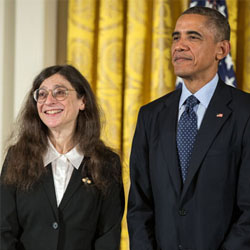August 07, 2015
Renowned entomologist and National Medal of Science Award winner Dr. May Berenbaum will be honored at Sigma Xi’s Annual Meeting with the Society’s John P. McGovern Award. The award recognizes an outstanding contribution to science and society. We spoke with her about her research and how she captures the public’s attention about insects.
 You’re doing research with the United States Department of Agriculture about honeybees and how they regulate toxins. What are your goals for that project?
You’re doing research with the United States Department of Agriculture about honeybees and how they regulate toxins. What are your goals for that project?
The first images that were drawn based on microscopic examination were those of honeybees back in 1625. So honeybees have been subject to extensive scientific investigation but in all that time very little was known about how honeybees metabolize poisons or toxins. This has become important because in contemporary American agriculture, they can’t forage in American cropland without encountering pesticides. Moreover, ever since the mid-1980s when a parasitic mite was accidentally introduced in the United States, called the varroa mite, it caused massive mortality and beekeepers have very few tools for dealing with this pest, which kills honeybees. What they’ve been using are pesticides. But it’s very difficult to design a pesticide that kills mites that doesn’t also kill insects because mites and insects are closely related.
For the first time in their long, evolutionary history honeybees have been encountering a toxin-drenched environment. They evolved in the context of being partners, or mutualists, with plants. They feed on nectar and pollen which, unlike most other plant parts, are not heavily defended by chemicals.
One thing that got us really interested in this was in 2006, the honeybee genome was completely sequenced and that sequence was published and there were big surprises. One was that honeybees have a smaller inventory of genes involving detoxification. So what got me interested is: How are they coping with this chemically different world?
[This research includes toxins that are naturally in plants and toxins that are applied to plants.] Bees, like most insects, are stuck with the biochemical equipment that they acquired over long evolutionary histories to deal with these chemicals.
What have you found?
We were surprised to find out there’s a chemical called p-coumaric acid which is present in honey and pollen. It’s the building unit of the polymer that makes up pollen cell walls, called sporopollenin. When bees ingest p-coumaric acid it turns on their detoxification enzymes.
Now that made us sit back and think: What happens when beekeepers feed their bees not honey to get them through the winter, but high-fructose corn syrup or sugar because it’s cheaper than honey? And for years this was a practice among beekeepers, since the late 1970s. But what happens to bees who are not consuming honey or pollen, [that] don’t get this [detoxification] signal?
As it turns out, if you feed bees just sugar instead of honey, they are less able to metabolize pesticides. That suggests a potential application. If beekeepers are economically strapped or don’t have the honey to provide to their bees, maybe just adding these inducers of detoxification might help bees cope better with pesticides. We didn’t start out with the idea of developing dietary supplements for honeybees but that’s where the research led us unexpectedly.
It sounds like you’re doing similar projects with the navel orangeworm.
This is a caterpillar that, name notwithstanding, is a major pest of nut crops in California. It has an extraordinary broad range of host plants. Ninety-plus percent of caterpillars that feed on plants, feed on plants in only one or two host families. But then there are the breakout artists like navel orangeworm that figured out a way to feed on dozens of very chemically different families. I’m trying to figure out how they biochemically deal with so many different types of chemicals.
You are the organizer of the Insect Fear Film Festival at University of Illinois at Urbana-Champaign. It draws in hundreds of people to learn about bugs with a bug petting zoo and student art contest. How is that going?
It’s going great. We are entering our 32nd year. The idea is to show insect science fiction films, which draws a crowd, and then explain to them what they’re about to see can’t possibly happen. And this way we can acquaint people with the biology of insects, their insect physiology, and insect ecology in an entertaining way and it’s been a lot of fun. You couldn’t draw a crowd advertising insect physiology but you can draw a crowd advertising a film featuring giant ants in the sewers of Los Angeles.
To learn Dr. May Berenbaum’s opinion on the first national strategy to help pollinators, as well as her thoughts on The X-Files character and cockroach species named after her, watch the full interview at her award page.
Photo: Dr. May Berenbaum, a professor and head of the Department of Entomology at the University at Urbana-Champaign, joined Sigma Xi in 1981. She received the National Medal of Science from U.S. President Barack Obama in 2014. (Image courtesy of May Berenbaum.)